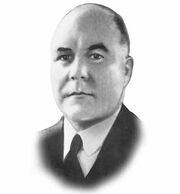
A photo of James E. Norris.
James E. Norris (December 10, 1879 – December 4, 1952) was a Canadian-American businessman, operating companies in the grain and cattle industries, and owner of the Detroit Red Wings of the National Hockey League. He also had significant ownership interests in the Chicago Black Hawks and the New York Rangers. He is often referred to as James Norris Sr., to distinguish him from his son, James D. Norris. Norris is a member of the Hockey Hall of Fame, as are his sons James and Bruce Norris.
Career[]
Norris was born in St. Catharines, Ontario, but grew up in Lachine, Quebec, a suburb of Montreal. He was an accomplished athlete in his youth, playing hockey, squash and tennis. He was a Defenceman at McGill University, and later played in 3 games in 1898 for the Montreal AAA.
Norris's family had amassed substantial wealth in the 19th century, owning mills and a fleet of ships, along with several tracts of land. His father moved Norris Grain Inc. to Chicago when Norris was 18 years old. Norris also moved to Chicago and became president of Norris Grain at the age of 28 in 1908. He began buying grain elevators in the 1910s and was the largest cash grain buyer in the world in the 1930s. He also ran Norris Cattle Company, which operated three of the largest cattle ranches in the U.S. His net worth was said to be over $200 million by 1940. Norris became a U.S. citizen in 1919.
When the NHL announced in 1926 that it would place a team in Chicago, Norris made a bid for the team, but lost to Frederic McLaughlin. Norris was one of the financial backers of the Chicago Stadium, which opened in March 1929. At that time, Norris and Stadium president Paddy Harmon had discussions with Frank Patrick about bringing another hockey team to Chicago, but under NHL rules, that would only be possible with McLaughlin's approval, which he would not give. McLaughlin found negotiations with Harmon and Norris for ice time at the Stadium to be difficult, but the two sides came to an agreement during the 1929–30 season.
Later in 1930, Norris was one of the backers of the Chicago Shamrocks of the minor league American Hockey Association, which changed its name to the American Hockey League (no relation to the current circuit). The AHL was declared an "outlaw league" by NHL president Frank Calder, and in an attempt to separate Norris from the league, the NHL let Norris know that he would be welcomed as an NHL owner. Norris withdrew his support from the Shamrocks (the team disbanded after the 1931–32 season). In May 1932, Norris applied to the NHL for a team in St. Louis, but this was rejected by the league because of concerns over travel expenses for the other teams. Norris had an agreement to buy the financially struggling Ottawa Senators, and intended to move the team to Chicago or Toronto. McLaughlin said he would not allow a second team into Chicago, and Maple Leafs owner Conn Smythe rejected the idea of another team in his city.
In 1931, the Detroit Falcons and their arena, the Detroit Olympia, had been placed into receivership and were being managed by a creditors' committee. By the summer of 1932, it was being reported that the team might be sold to Norris. In the fall of 1933, the NHL formally approved Norris' bid to acquire the team from the receiver. He changed the team's name to the Detroit Red Wings. Norris also designed the team's current logo—a wing protruding from a wheel. The logo was adapted from the old Montreal AAA logo (the team had been nicknamed the "Winged Wheelers" after the bicycle team) and was intended to curry favor with the automobile companies.
Norris quickly cleared away the debt left over from past years and gave the Red Wings the financial backing they needed to become one of the most powerful teams in the NHL. Under Norris' watch, the Red Wings won five Stanley Cups. He rarely saw his Red Wings play due to a heart condition. However, coach and general manager Jack Adams always called Norris after each game from the locker room.
When McLaughlin died in 1944, Norris helped longtime Black Hawks president Bill Tobin put together a syndicate that bought the team from the McLaughlin estate. It was generally understood, however, that Norris called the shots. He had bought Chicago Stadium in 1936, thus making him the Black Hawks' landlord. Earlier in the decade, he had bought enough stock in Madison Square Garden to become its largest stockholder, and while he did not buy majority control (he was forbidden from doing so by the NHL constitution), he had enough support from the board that he effectively controlled the New York Rangers as well.
Norris died on December 4, 1952 in Chicago and was buried in Mattituck, New York. Upon his death, the shipping company he owned, Upper Lakes Shipping, named a Great Lakes bulk carrier after him. The ship is still in service and carries his name to this day. He was elected to the Hockey Hall of Fame in 1958.
Legacy[]
The James Norris Memorial Trophy, awarded to the top defenseman in the NHL, first awarded in 1954 was named in his honor. The league's former Norris Division, which existed from 1974 to 1993, was also named after him. There was also a James Norris Memorial Trophy in the International Hockey League which was awarded to the top goaltender.
Awards[]
Stanley Cup Champion as President - 1936, 1937, 1943, 1950, 1952 - with Detroit.
| This page uses content from Wikipedia. The original article was at James E. Norris. The list of authors can be seen in the page history. As with Ice Hockey Wiki, the text of Wikipedia is available under the Creative Commons Attribution-Share Alike License 3.0 (Unported) (CC-BY-SA). |
